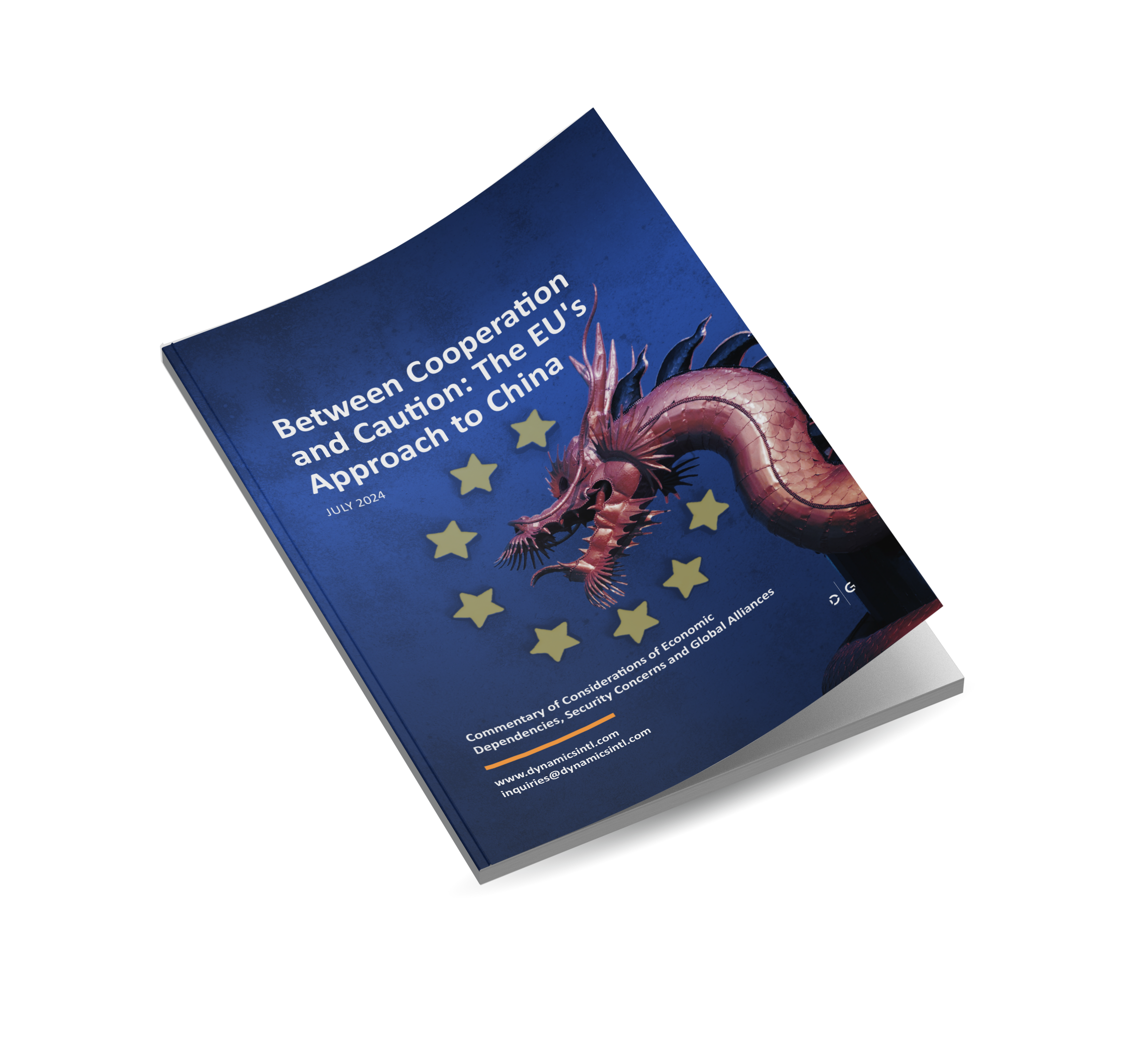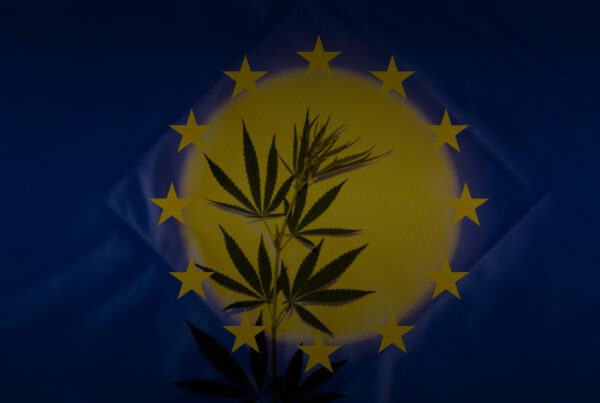Listen to the article – Between Cooperation and Caution: The EU’s Approach to China
The relationship between the European Union (EU) and China is characterized by significant economic interdependencies and complex geopolitical considerations.
Over the past three decades, China has evolved into the EU’s most significant trading partner, a relationship which involves massive mutual trade volumes and substantial investments. This economic interdependence influences many policy decisions within the EU.
However, economic cooperation is carefully weighed against strategic autonomy reflecting the EU’s need to maintain control over its strategic sectors while engaging China as a key economic partner.
How can we help?
Intelligence Solutions
The combination of business, market and strategic intelligence ensures result-driven outcomes for our customers.
Risk management
Risk management through the responsibility of taking risk ownership while ensuring safety and security
Strategic Advisory
The first step in protecting your organization, assets and people is the identification of the risks and threats.
The following factors have been identified to be part of the two parties’ strategic calculations:
- Economic Interdependence: Over the last three decades, China has become the EU’s largest trading partner. This partnership is driven by extensive trade and substantial investments, which significantly influence policy decisions within the EU.
- Balancing Acts: The EU is constantly assessing how to balance its economic relations with China against the need to maintain strategic independence. It is vital for the EU to manage this balance for protecting its geopolitical and economic interests while reaping the benefits of economic cooperation.
- Varied Responses Across the EU: EU member states show a range of approaches towards China, shaped by their own economic interests and security needs. Germany and Italy, for example, have deep economic connections with China which shape their foreign policy. In contrast, Poland and the Czech Republic exercise more caution, largely due to their security alignments with the U.S.
- Safeguarding Interests: The EU places great emphasis on monitoring and screening foreign investments, especially those from China, to prevent undue influence and protect sensitive sectors. This approach is essential for defending crucial technologies and infrastructure from external risks.
- Looking Ahead: The future could see scenarios ranging from closer cooperation to increased tensions and the possibility of strategic separation. These future paths depend on shifts in political alliances, economic strategies, and global events.
01
Foreword
01
Foreword
Since the mid-1990s, the economic and strategic relationship between the EU and China has massively transformed with China rising to become the EU’s most significant trading partner. This development created a complex network of economic dependencies characterized by substantial trade volumes and investments. As a result, numerous European businesses now depend on the Chinese market for their functioning.
The true scale of complexity of this relationship is evident in the varied strategies and priorities of individual EU member states, influenced by their specific economic conditions and political landscape. For example, Germany shows significant economic ties to China, heavily involving Chinese suppliers and consumers. Conversely, countries like Italy and France have adjusted their economic engagements based on strategic considerations, which reflect recent political changes and the need to manage technological dependencies.
Beyond economic considerations, the relationship is complicated by political and strategic issues. The EU has raised concerns about China’s human rights record, particularly in regions like Xinjiang, Hong Kong, and Tibet. Security concerns also play a role, with the EU cautious of China’s assertive foreign policy, especially regarding Taiwan and the South China Sea.[1] Additionally, China’s strategic investments within the EU have raised worries about economic leverage translating into political influence. The varied approaches of EU member states add another layer of complexity to forming a cohesive “China policy.”
These factors will shape future scenarios for EU-China relations, influenced by the collective actions of the EU and the policies of individual member states.[2]
02
Economic Relations
02
Economic Relations
The EU-China economic relationship is an intrinsic part of global economic stability. Over the past thirty years, China turned into the EU’s “number one” trading partner.[3] This interdependence is manifested in the significant trade volumes and investments between the two entities. A large number of European companies rely heavily on the Chinese market for growth and profitability.
Germany is, perhaps, the best example of this economic interdependence. As one of the leading economies within the EU, Germany has particularly strong economic ties with China. Major German corporations including auto giants Volkswagen and BMW, electronics manufacturer Siemens and many other large and small corporations derive a substantial portion of their revenue from Chinese consumers. Spare parts, components and raw material particularly for electronics industry comprise another major trade aspect between Germany and China. Moreover, taking into consideration that most of the European industrial groups are connected across the block with various components being produced in several countries, this factor is critical for stability of EU economy as any disruptions in this relationship can lead to supply chain breakdowns not only for Germany but for the entire EU.[4]
Italy, another significant EU member, which has engaged deeply with China through initiatives like the Belt and Road Initiative (BRI). Italy’s participation in the BRI intended to attract substantial infrastructure investments to boost its economic growth. However, the political landscape has shifted under Prime Minister Giorgia Meloni, prompting Italy to reconsider its involvement in the BRI due to pressures from G7 partners and changing global dynamics.[5]
France, under President Emmanuel Macron, takes a highly nuanced approach to relations with China, which is about maintaining a delicate balance between immediate economic interests and strategic autonomy.
Download Report
Between Cooperation and Caution: The EU’s Approach to China
Commentary of Considerations of Economic Dependencies, Security Concerns and Global Alliances
Macron advocates for reducing dependency on Chinese technology while strengthening Europe’s industrial capabilities.[6] This strategy highlights France’s dual focus on maintaining economic ties with China while enhancing its own technological and industrial independence.
Spain and Portugal emphasize trade and investment opportunities while aligning with broader EU policies on technology transfer and market access.
The Netherlands has adopted a hard approach to foreign investments implementing strict measures to verify and scrutinize investments to protect its national infrastructure.[7] Austria supports economic partnerships, particularly in trade and tourism, while also backing EU efforts to address human rights issues. Poland takes a cautious stance towards China, driven by security concerns and strategic alignment with the United States. The Czech Republic prioritizes human rights, leading to strained relations with China. Hungary, in contrast, has deepened its ties with China, especially in infrastructure projects. All of these differences highlight the profound challenges in maintaining a unified EU policy towards China.
Despite the strong economic relationship there are significant imbalances. One of the most prominent issues is the substantial trade deficit that the EU faces with China. This deficit is driven by high demand for Chinese goods within the EU and intense competition in high-value sectors such as automobiles and luxury goods. Efforts to finalize the Comprehensive Agreement on Investment (CAI) have encountered numerous obstacles due to political disagreements and sanctions.[8] The CAI, once seen as a potential cornerstone of EU-China economic relations, now faces an uncertain future as both sides address underlying tensions and disagreements.
The COVID-19 pandemic exposed weaknesses in global supply chains, particularly highlighting the EU’s reliance on Chinese imports for essential goods. In response, the EU has intensified efforts to diversify supply chains and reduce dependency on China. This strategy involves investing in alternative sources, promoting regional supply chains, and developing partnerships with other countries to create more reliable and secure networks.[9] The pandemic underscored the need for the EU to build more diversified supply chains to mitigate the risks associated with over-reliance on any single market, including China.
03
Political and Strategic Considerations
03
Political and Strategic Considerations
While economic ties between the EU and China are strong, their relationship faces significant political and strategic challenges. The EU has consistently raised concerns about China’s human rights record, particularly regarding the treatment of Uighurs in Xinjiang, the crackdown on freedoms in Hong Kong, and the situation in Tibet.[10] These human rights concerns have strained political relations between the EU and China. From China’s perspective, the EU’s stance on human rights is seen as interference in its domestic affairs, complicating bilateral relations.[11]
Security concerns also play a crucial role in the EU’s cautious engagement with China. The EU is wary of China’s assertive foreign policy, particularly its actions concerning Taiwan and the South China Sea.[12] These geopolitical tensions have prevented deeper cooperation between the EU and China, fostering mutual distrust. The EU’s apprehensions are heightened by China’s close ties with Russia and its activities related to technological espionage. These factors have led to limited defense cooperation between the EU and China, with the EU implementing measures to secure its digital infrastructure against potential threats from Chinese technology companies.[13]
The EU’s strategic considerations are not solely focused on external threats. The EU actively seeks to diversify its supply chains to reduce dependency on China. The COVID-19 pandemic revealed significant vulnerabilities in global supply chains, particularly the EU’s reliance on Chinese imports for essential goods and medical supplies. This reliance has prompted the EU to invest in alternative sources, promote regional supply chains, and develop partnerships with other countries to create more reliable networks.[14] These efforts are part of the EU’s broader goal of achieving strategic autonomy and reducing dependencies on external powers, including China.[15]
In addition to human rights and security concerns, the EU is also cautious of China’s influence[16] within the EU itself. China’s strategic investments in key infrastructure projects across Europe have raised concerns about the potential for economic leverage to translate into political influence. For instance, China’s acquisition of the Piraeus Port in Greece and substantial investments in Hungary have been viewed with suspicion by other EU member states.[17] These investments have led to fears that China’s economic presence could undermine the EU’s unity and coherence on key policy issues.
The EU’s political and strategic considerations are further complicated by the diverse approaches of its member states towards China. While some countries, like Germany and Italy, advocate for continued engagement due to their significant economic ties, others, like Poland and the Czech Republic, prioritize human rights and security concerns. This diversity of approaches makes it challenging for the EU to formulate and implement a cohesive “China policy” that addresses both economic interests and strategic concerns.[18]
04
Differences in Member States’ Approaches and Challenges
04
Differences in Member States’ Approaches and Challenges
The EU’s relationship with China is complicated by the diverse approaches and priorities of its member states. Each country within the EU has unique economic ties, political priorities, and security concerns, making it difficult to create and implement a unified policy towards China.
Germany supports continued engagement with China due to its deep economic ties, particularly in the automotive and machinery sectors. Germany’s significant economic relations with China often drive a preference for a balanced approach, emphasizing the importance of maintaining strong trade ties while addressing strategic concerns.[19] Italy, after initially joining the BRI to boost its economy through infrastructure investments, is reconsidering its position due to broader geopolitical pressures and criticisms from other EU members and the United States.[20]
France represents a nuanced approach, balancing economic cooperation with a firm stance on human rights and strategic autonomy. Under President Emmanuel Macron, France advocates for reducing dependency on Chinese technology while strengthening Europe’s industrial capabilities.[21] This strategy highlights France’s dual focus on maintaining economic ties with China while enhancing its own technological and industrial sovereignty.
Eastern European countries and the Baltic states adopt a more cautious stance towards China, driven by security concerns and strategic alignment with the United States. These countries are wary of China’s growing influence and its close ties with Russia.[22]
How can we help?
Intelligence Solutions
The combination of business, market and strategic intelligence ensures result-driven outcomes for our customers.
Risk management
Risk management through the responsibility of taking risk ownership while ensuring safety and security
They push for stronger human rights stances and the protection of critical infrastructure, reflecting a more cautious approach to engagement with China.
The rise of right-wing parties in Europe adds another layer of complexity to the EU’s relationship with China. These parties often adopt nationalist and protectionist stances, advocating for reduced dependency on foreign powers, including China. For instance, Italy under Giorgia Meloni expresses skepticism about China’s intentions and reconsiders its participation in the BRI.[23] Hungary, under Viktor Orbán, balances economic engagement with China while addressing national sovereignty concerns.[24] Hungary’s deepening ties with China, particularly in infrastructure projects, highlight the challenges of maintaining a unified EU policy towards China.

The EU’s strategy increasingly focuses on achieving “strategic autonomy” by reducing dependency on external powers while maintaining economic relations. This involves diversifying supply chains, investing in domestic capabilities, and enhancing regulatory frameworks to protect critical sectors. However, aligning these objectives with the diverse perspectives of individual member states remains a challenge. Some EU countries might pursue independent strategies driven by national interests, further complicating the formulation of a cohesive EU policy.[25]
For instance, Germany supports Chinese investments in its critical infrastructure despite security concerns from other EU members. Italy, under Prime Minister Meloni, faces the challenge of balancing economic opportunities with security concerns and transatlantic relationships. France emphasizes reducing dependency on Chinese technology and strengthening Europe’s industrial capabilities. Spain focuses on trade and investment while remaining cautious about strategic dependencies. Portugal welcomes Chinese investments but aligns with broader EU policies on technology transfer and market access.
The Netherlands maintains a competitive and open market while safeguarding national security through stringent measures on foreign investments, including those from China.[26]
Austria supports economic partnerships with China but also backs EU efforts to address human rights issues. Poland adopts a cautious approach driven by security concerns and strategic alignments with the United States. The Czech Republic prioritizes human rights issues, which sometimes strains bilateral relations with China. Hungary embraces Chinese investments, particularly in infrastructure projects, but often diverges from broader EU strategies, leading to tensions within the EU.[27]
Balancing economic interests with political and security concerns that China poses to the world is a challenge for the EU despite the obvious and immediate economic benefits. Deep engagement with China raises questions about strategic dependency, strategic vulnerabilities, and the mismatch with the EU’s commitment to human rights and democratic values. These issues will continue defining the EU’s internal political dynamics in the future, influence the debates and policies within the EU as interests of some business groups align with different political leaders. Some leaders, supported by sectors negatively impacted by competition or regulatory pressures from China, will advocate for restricting and scaling back relations. On the other hand, leaders backed by industries that thrive on Chinese partnerships and market access will push for even deeper engagement. This dichotomy will keep the “China issue” a key factor in shaping both the economic strategies and political landscape of the EU.
05
External Influences and Implications
05
External Influences and Implications
The relationship between the EU and China is not only influenced by internal dynamics but also by other geopolitical factors. Two significant external influences are the strategic policies of the United States and the ongoing Russia-Ukraine war.
The United States plays a pivotal role in shaping EU-China relations through its global policies and measures. The Biden administration’s focus on “de-risking” rather than complete “decoupling” from China aligns with European strategies.[28] This approach includes export controls, investment screenings, and sanctions against Russia. The Biden administration encourages reducing dependencies on China without severing economic ties. The EU similarly focuses on diversifying supply chains and protecting critical sectors. The US pressures the EU to implement stricter controls to prevent sensitive technologies from reaching China. In response, the EU has tightened its regulations on foreign investments in critical areas, reflecting a coordinated transatlantic effort to manage the risks associated with economic engagement with China.[29]
The potential re-election of Donald Trump could introduce more aggressive policies towards China, increasing pressure on the EU. Trump’s policies might lead to increased scrutiny of Chinese investments and stricter export controls, which could strain transatlantic relations.[30] These policies could create tensions between the US and the EU, complicating coordinated efforts to address challenges posed by China. The EU would need to navigate the complexities of balancing its economic interests with China while aligning with US policies under a more confrontational US administration.[31]
The ongoing Russia-Ukraine war has also significantly affected the EU-China relations. China’s ambiguous stance on the conflict complicates its relationship with the EU as the EU views China’s support for Russia as a major problem for the European security.[32] The EU has imposed numerous sanctions on Russia complicating its dealings with China. Some of the sanctions, if enforced properly, can have second-tier effect on Chinese business in the EU.
Nonetheless, China’s partnership with Russia has deepened during the war. Although China calls for peace, it continues to import Russian energy and supply dual-use goods, which puts the EU in a difficult position.[33]
Download Report
Between Cooperation and Caution: The EU’s Approach to China
Commentary of Considerations of Economic Dependencies, Security Concerns and Global Alliances
EU sanctions target key sectors of Russia’s economy, but China’s support for Russia undermines these sanctions, exacerbating tensions with the EU. European companies face increased scrutiny when dealing with Chinese firms suspected of circumventing sanctions. This conflict has further intensified efforts[34] to reduce dependencies on Chinese imports and reassess strategic vulnerabilities.
The EU has launched initiatives to diversify supply chains, invest in domestic manufacturing, and establish trade relationships with other regions. The Global Gateway strategy aims to develop infrastructure and connectivity projects that diversify supply routes and reduce dependencies on Chinese suppliers.[35] This strategy is part of the EU’s broader goal of achieving strategic autonomy and enhancing resilience against future disruptions. The EU is also increasing cooperation with NATO and international partners to counter potential threats, emphasizing resilience and preparedness against hybrid threats like cyber-espionage and economic coercion.
06
Scenario Analysis for Eu-China Relations
06
Scenario Analysis for Eu-China Relations
Considering the diverse interests and strategic priorities of EU member states, it becomes clear that the future of EU-China relations is influenced by economic dependencies, security concerns and geopolitical alliances. Therefore, a number of scenarios could unfold depending on the EU’s collective actions and individual member states’ policies.
The following are three potential scenarios reflecting different degrees of alignment with the US, economic engagement with China and considerations of the EU strategic autonomy.
| Scenario | Key Factors | Likelihood |
| Scenario 1: Strategic Alignment with the USA | - Economic Sanctions and Decoupling: Stricter sanctions and export controls targeting Chinese industries. - Geopolitical Tensions: Increased naval presence in Asia-Pacific and support for Taiwan. - Unified Western Bloc: Strengthened transatlantic alliance. | MODERATE |
| Scenario 2: Balanced Engagement | - Economic Cooperation with Safeguards: Continued trade with stringent regulations on critical sectors. - Multilateral Diplomacy: Engaging China through global platforms like the G20 and WTO. - Strategic Autonomy: Diversifying supply chains and investing in domestic capabilities. | HIGH |
| Scenario 3: Increased Tensions and Decoupling | - Stricter Controls on Investments: Comprehensive screening and bans on Chinese FDI in sensitive sectors. - Retaliatory Economic Measures: China’s retaliatory tariffs and regulatory scrutiny on European companies. - Supply Chain Disruptions: Need for alternative sources for essential goods, leading to shortages and price increases. - Global Instability: Fragmented international relations and increased conflict risk. | LOW |
Scenario 1: Strategic Alignment with the USA
In this scenario, the European Union (EU) aligns closely with US policies, leading to stronger sanctions on China and coordinated efforts to counter China’s global influence. This alignment would result in a more unified Western bloc, though it could exacerbate economic decoupling and increase geopolitical tensions.
Key Factors:
- Economic Sanctions and Decoupling: The EU, under pressure from the US, would implement more stringent sanctions targeting key Chinese industries, particularly in technology and finance. This would involve comprehensive export controls on sensitive technologies and restrictions on Chinese investments in critical European sectors. Such measures would aim to curtail China’s ability to benefit from European technologies for its military and strategic gains. For example, the EU might follow the US in restricting exports of semiconductor technologies to China significantly impacting Chinese tech giants like Huawei and SMIC.
- Geopolitical Tensions: Aligning closely with the US could intensify geopolitical tensions, particularly in the Asia-Pacific region. The EU might increase its naval presence in the South China Sea to support freedom of navigation operations aligning with US military strategies. This could lead to confrontations with Chinese forces and escalating regional tensions. Additionally, the EU could reinforce its support for Taiwan enhancing political and economic ties, which would further strain relations with Beijing.
- Unified Western Bloc: A stronger alignment with the US would solidify the transatlantic alliance presenting a united front against China’s global ambitions. This unified approach would enhance the West’s ability to negotiate with China from a position of strength, potentially forcing Beijing to adhere to international norms and reduce unfair trade practices. However, the economic costs of decoupling would be significant affecting industries dependent on Chinese markets and supply chains.
Scenario 2: Balanced Engagement
In this scenario, the EU seeks to balance its strategic autonomy by maintaining significant economic ties with China while addressing security concerns through targeted regulations and multilateral diplomacy. This approach involves careful handling of pressures from both the US and China and adopting a pragmatic stance in bilateral relations.
Key Factors:
- Economic Cooperation with Safeguards: The EU would continue to engage economically with China benefiting from trade and investment opportunities for the European industries. However, it would implement stringent regulations to safeguard critical technologies and infrastructure. For example, the EU might enforce its Foreign Direct Investment (FDI) screening mechanisms to prevent Chinese acquisitions of sensitive technologies while promoting mutually beneficial projects in sectors like green energy and digitalization.
- Multilateral Diplomacy: The EU would emphasize multilateral diplomacy to manage its relationship with China engaging in dialogue through platforms like the G20 and the World Trade Organization (WTO). This approach would aim to address global challenges collaboratively including climate change, cybersecurity, and public health. By promoting international cooperation, the EU could mitigate some of the strategic risks associated with its economic engagement with China.
- Strategic Autonomy: Maintaining strategic autonomy would be central to this scenario. The EU would avoid over-reliance on either the US or China promoting a balanced approach that protects European interests. This would involve diversifying supply chains to reduce dependency on Chinese imports and investing in domestic capabilities to strengthen resilience. For instance, the EU might increase funding for research and development in critical sectors ensuring that European innovations remain competitive globally.
Scenario 3: Increased Tensions and Decoupling
In this scenario, escalating geopolitical conflicts and mutual distrust lead to increased economic decoupling and political isolation. The EU imposes stricter controls on Chinese investments and technology transfers, while China retaliates with economic measures, heightening global instability and disrupting supply chains.
Key Factors:
- Stricter Controls on Investments: The EU would impose strict controls on Chinese investments, particularly in high-tech and critical infrastructure sectors. This would involve comprehensive screening of all Chinese FDI and possibly banning investments in sensitive areas altogether. The aim would be to protect European technologies and infrastructure from potential exploitation and espionage by Chinese entities.
- Retaliatory Economic Measures: In response, China would likely implement retaliatory measures against European companies operating in China. This could include increased regulatory scrutiny, tariffs and restrictions on European imports significantly impacting European businesses reliant on the Chinese market. Key industries such as automotive, luxury goods and pharmaceuticals could face substantial losses leading to economic disruptions.
- Supply Chain Disruptions: Decoupling would lead to significant disruptions in global supply chains. The EU would need to find alternative sources for essential goods and raw materials previously sourced from China. This process would be complex and costly, potentially leading to shortages and increased prices for European consumers and businesses. The disruption of supply chains could also impact the global economy, given the interdependence of international trade networks.
- Global Instability: The heightened tensions and economic decoupling would contribute to global instability. With two major economic blocs increasingly isolated from each other, the risk of conflict could rise. Additionally, the global economy would suffer from reduced cooperation on critical issues such as climate change, pandemics and technological standards. The fragmentation of international relations could lead to a more volatile and unpredictable global environment.
Overall Scenarios’ Assessment:
In evaluating the EU-China relationship, several key parameters must be considered. These include economic interdependence, strategic autonomy and security, political dynamics within the EU and geopolitical considerations.
- Economic Interdependence: The EU and China are deeply linked economically. China is the EU’s largest trading partner. In 2023, EU-China trade reached high levels despite geopolitical tensions. The economic benefits of these ties are strong. There are strong reasons against complete separation. This aspect is important because the mutual economic benefits help stabilize the relationship and provide strong incentives to avoid severing ties.
- Strategic Autonomy and Security: The EU is strengthening its rules to protect important sectors from foreign influence, especially China. New measures include screening foreign investments and controlling exports of sensitive technologies. These steps aim to protect European technology while keeping economic relations with China. This aspect is absolutely crucial because it helps the EU maintain control over its strategic sectors and reduce dependency on external powers ensuring long-term stability and security.
- Political Dynamics within the EU: Different interests among EU countries require a balanced approach. Germany and Italy want to keep strong economic ties with China due to economic connections. France and Poland focus on security and human rights and want stricter measures. This aspect is important because the EU needs to find a unified stance that respects the diverse priorities of its member states, which is essential for cohesive and effective policymaking.
- Geopolitical Considerations: Aligning too closely with the US could increase tensions and costs. The Biden administration’s strategy of “de-risking” aligns with the EU’s approach. This strategy focuses on reducing risks without cutting off economic relations with China. This aspect is significant because it allows the EU to balance its relationships with both the US and China minimizing geopolitical tensions and economic disruptions.
Taking into consideration the above – Scenario 2: Balanced Engagement, is the most probable outcome for EU-China relations in the short to mid-term perspectives. Such approach keeps important economic ties with China while addressing security concerns with targeted rules and international cooperation. The different interests of EU countries and the need to balance relationships with both the US and China support this pragmatic approach. In other words, this scenario provides a middle ground helping to maintain economic benefits while protecting the EU’s strategic and security interests.
Scenario 1 has a moderate chance of occurring, while Scenario 3 is least likely due to the widely recognized potential negative consequences for all parties involved.
07
Concluding Remarks
07
Concluding Remarks
The relationship between the European Union (EU) and China is a combination of economic interdependence, long-term strategic considerations and geopolitical challenges.
Over the past few decades China established itself as a one of the most importantly economic partners for the EU, which is proved by significant trade volumes and investments. European industries, particularly in sectors such as automotive, technology and luxury goods, rely heavily on the Chinese market. This deep economic connection drives a pragmatic approach to maintaining and enhancing trade ties despite growing geopolitical tensions and security concerns.
As was indicated – given the current geopolitical context and the diverse interests within the EU, Scenario 2: Balanced Engagement is the most probable outcome for EU-China relations. This scenario aligns with the EU’s need to maintain economic ties with China while safeguarding strategic and security interests through targeted regulations and multilateral diplomacy.
Future Outlook (Next 12 Months – 3 Years):
- Short-term (Next 12 Months): The EU will likely continue toughening up its regulatory measures focusing on protecting critical technologies and infrastructure from foreign influence. Economic ties with China will remain strong and driven by significant trade volumes and investments. Multilateral diplomacy will remain a key tool for managing geopolitical tensions and addressing global challenges such as climate change and public health.
- Medium-term (1-3 Years): The EU is expected to strengthen its strategic autonomy by diversifying supply chains and investing in domestic capabilities. Relations with the US will remain important with continued coordination on policies towards China. The EU will likely pursue a balanced approach maintaining economic engagement with China while addressing security concerns through multilateral platforms and targeted regulations. Overall, the situation is expected to remain largely the same as it is today.
POST SCRIPTUM
POST SCRIPTUM
This analysis has examined the complex relationship between the European Union and China, focusing on the established economic interdependencies, strategic priorities and geopolitical considerations.
It has offered various potential scenarios for this relationship taking into account the combination of internal policies, shifts in the global economic landscape and global strategic realignments. It is recognized that real-world developments, leadership decisions, and unforeseen events significantly influence these dynamics, thereby necessitating the acknowledgement of certain limitations, potential inconsistencies, analytical oversights, assumptions and other contextual factors to ensure a comprehensive understanding of the analysis.
Assumptions Regarding Global and Regional Stability:
- The analysis presupposes a stable geopolitical environment wherein major powers sustain their current foreign policies. However, abrupt shifts in international politics or economic downturns could modify the foundational dynamics discussed.
- It projects a consistency in EU policy responses, although variations in political resolve among member states could lead to disparate approaches, influencing the overall EU strategy toward China.
Economic Forecasts and Dependencies:
How can we help?
Intelligence Solutions
The combination of business, market and strategic intelligence ensures result-driven outcomes for our customers.
Risk management
Risk management through the responsibility of taking risk ownership while ensuring safety and security
- Economic ties are evaluated based on present trade volumes and investment flows. Future economic conditions, such as disruptions in markets or alterations in global trade policies, could influence these forecasts.
- The analysis also presupposes ongoing economic openness in China, but the adoption of protectionist policies or significant economic reforms could reshape these dynamics.
Strategic Considerations and Security Interests:
- The research relies on the current strategic orientation of the EU and its alignment with the US. Any movement towards more autonomous or divergent policies could impact the EU’s approach to China.
- Security concerns are considered with the assumption of continuing technological and defense alignments. Changes in security doctrines or significant technological breakthroughs could influence future EU strategies.
Human Rights and Political Engagement:
- The emphasis on human rights issues presupposes that the EU continues to prioritize these concerns in its foreign policy. Policy shifts or changes in leadership could modify how these issues are approached.
- Political engagement is assumed to follow existing diplomatic channels. However, new leadership or shifting domestic priorities in EU member states could reshape these interactions.
Realpolitik Nuances:
- Although the analysis provides only select considerations of realpolitik from the individual EU member states’ point of view, these are are important parameters and subject to the fluid nature of international relations. New alliances or conflicts could significantly influence the strategic calculations of both the EU and China.
- The presumption of rational decision-making by all stakeholders is based on current political environments, but ideological shifts or internal pressures could lead to unexpected decisions.
Information and Data Sources:
- This research draws on a diverse selection of sources, including economic data, policy documents and expert opinions. The reliability and timeliness of these sources are crucial, yet there is always a risk of biases or incomplete information shaping the conclusions.
- Continuous verification and updates are essential to ensure the analysis remains pertinent in the face of rapidly changing global and regional contexts.
Long-Term Engagements and Strategic Autonomy:
- The scenarios developed assume that policies on strategic autonomy and engagement will proceed without major interruptions. However, the actual implementation of these policies may confront challenges from internal EU disagreements or external pressures, which could affect their effectiveness and sustainability.

ARTICLE | 29 PAGES






